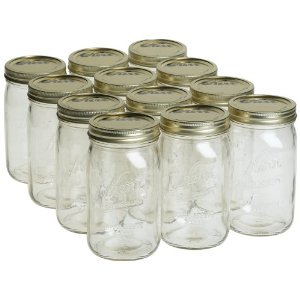using the low immersion technique with iDye
using the low immersion technique with iDye
Name: Isabelle
Country or region: Canada
Message: I'm trying to dye a 100% cotton fabric using the low immersion technique, and have two packets of iDye... is it possible to mix the dye in cold water, let it soak with the fabric, and then use hot water to set it, or use hot water in the fabric bath? or should I just get a cold water dye?
You should do your low water immersion dyeing with heat, when you use iDye or any other direct dye.
Find a non-reactive container that your fabric will fit into tightly when crumpled, such as a quart-sized glass canning jar. Use one jar for each piece of fabric. Add the fabric, salt, and some of the water to your glass jar, then mix the dye(s) with enough water to dissolve them and pour them over the fabric. Add more water as needed to almost cover the fabric, allowing enough space at the top of the jar that spillage is not likely.
Now, place your glass jars inside a cooking pot that is large enough to hold them, along with enough water, on the outside of the jars, to equal the level of your dyebath inside the jars. Gently heat this pot on the stovetop until the water around the outside of the jars begins to produce small bubbles, then reduce the heat and maintain this temperature for half an hour or longer. There is no need to stir the fabric in the jars with the dye; doing so will reduce the interesting patterns produced by low water immersion dyeing.
Turn off the heat and allow your dyes to cool, then rinse out the excess dye as usual.
A good variation would be to use a cheap but watertight styrofoam cooler. Place the jars into the cooler, and pour boiling water (heated on the stovetop) around them, taking care not to increase to level of the water to a greater depth than the water plus dye inside the jars (and not to accidentally pour water into a jar). Put the lid on top of the cooler. The cooler will maintain heat for some time, allowing the dye to bond as well as possible to the fibers.
For pale colors, use less dye and less salt; for deep colors, use more dye. Be sure to prewash your fabric before dyeing it. Each packet of iDye should be enough to dye two to three pounds of fabric, so, for smaller pieces of fabric, you may not wish to use the entire packet. I recommend placing the inner packet of dye, which is in a water-soluble clear packet, inside a freezer-type zip-top plastic bag, before cutting into the packet, if you are going to use less than an entire packet, carefully reaching into the zip-top bag with a washable pair of scissors. Otherwise, particles of dye powder are likely to fly everywhere when you cut into the packet.
After dyeing your fabric, it is a good idea to use a cationic dye fixative, such as Retayne, because iDye contains direct dyes, which are not very washfast. Unlike fiber reactive dyes such as Procion MX dyes, direct dyes tend to bleed in the laundry, and fade relatively quickly, since they do not form a strong bond to the fiber. A cationic dye fixative, such as Retayne, increases the washfastness of direct dyes considerably.
If you use a fiber reactive dye, such as Procion MX dye, instead of iDye, you can skip the heating step, as well as the cationic after-fixative, since fiber reactive dye is washfast and permanent even without a fixative, as long as you add soda ash (washing soda) to the dye reaction. I think it's easier and more satisfactory. However, low water immersion dyeing certainly can be done with iDye or other direct dyes.
Posted: Tuesday - December 07, 2010 at 06:13 AM
Follow this blog on twitter here.
Quick Links
- All About Dyes & Dyeing Top -
- Top of this blog -
- FAQ -
- The Dye Forum -
- How to Tie Dye - How to Batik -
- Books - Toys - Plants -
- Top of this blog -
- FAQ -
- The Dye Forum -
- How to Tie Dye - How to Batik -
- Books - Toys - Plants -
More in this category:
- -
Statistics
Total entries in this blog:
Total entries in this category:
Published On: Aug 29, 2012 02:49 PM
Total entries in this category:
Published On: Aug 29, 2012 02:49 PM
